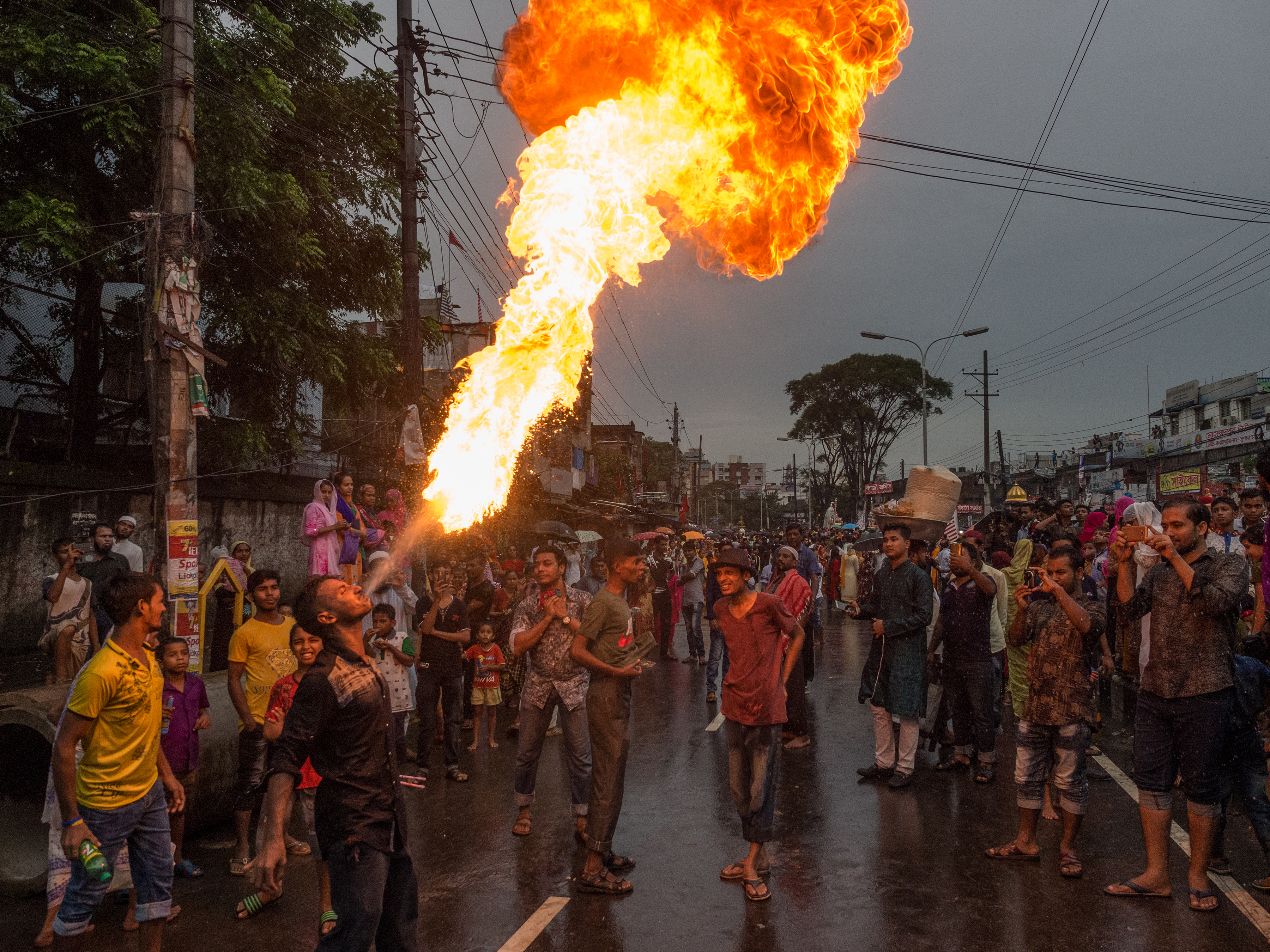A Bihari man performs fire breathing on a crowded street in Dhaka city during Ashura - a religious event held on the 10th day of the Arabic month of Muharram. Biharis are an ethnic minority in Bangladesh consisting of Muslim refugees displaced from the Bihar state of India during the partition of the Indian subcontinent. For nearly five decades now some 300,000 Biharis have been confined in 66 refugee camps in Bangladesh. Though they are entitled to Bangladeshi citizenship according to the country's citizenship laws, the state often does not recognise them as rightful citizens and routinely discriminate against them. Hence the camps remain as what Agamben (2005) called 'spaces of exception' where denied of citizenship rights and entitlements Biharis live as a stateless community invisible to the mainstream media and absent from the nation's socio-political imagination. The most commonly seen pictures of Biharis are thus images of victimization, acute poverty, and deprivation which are often produced for presenting to the international aid agencies and human rights organizations. This photograph stands out in sharp contrast to such tradition of producing visuals of the victimisation and marginalisation of Biharis. The fire breather in the photograph stands in a powerful, agentive and defiant posture while similar agency is also visible in the body language of the spectators documenting the event with their cell phones.
The most significant thing about this photograph however is rooted in a unique practice of Ashura celebration which enables the Biharis to build solidarity among the residents of different camps while claiming space and visibility from the authorities. Sunni Muslims commemorate Ashura as the day when God saved Moses and his followers from the Egyptian Pharaoh. To the Sunnis it is a day of solemn reflection and fasting, and does not involve any outward display or public events. For Shi'a Muslims, however, Ashura has great socio-political significance as this was also the day when prophet Muhammad's grandson Husayn was killed in a battle in Karbala, Iraq in AD 680. Shi'as interpret Ashura as a symbol of struggle between the forces of good and the forces of oppression and injustice. Historically, the mourning processions and public rituals of Ashura observed by the Shi'as have been considered as a form of resistance against oppressive regimes especially in countries where they have been a minority community. Despite being mostly Sunnis, the Biharis in Bangladesh have adopted the Shi'a way of commemorating Ashura. However, for Biharis it is a day of not mourning but of grand processions, colourful carnivals, and street performances. This allows the residents of all Bihari camps in a city to come together in solidarity - the only time of the year they are allowed to do so. The street shown in the photograph happens to be one of the busiest streets of Dhaka city that had to be closed down for the day by the police in order to regulate the processions and carnivals. For a day this enables the otherwise invisible Biharis to become highly visible to the nation - to overcome their marginalization and occupy the centre both in a physical and symbolic sense. To a certain extent they are aware of it and document the events with their cell phones for sharing among their networks. Cottle and Lester (2011) pointed out that with the advent of smart phones visuals of such demonstrations staged in one city are instantly transmitted through social media and resonate among similar communities across cities and borders. The adoption of this unique form of Ashura commemoration has thus become for the stateless Biharis an exercise in solidarity building and a form of resistance against the non-recognition of the majoritarian state of which this photograph remains a testimony.
References:
Agamben, Giorgio. (2005). State of exception
Cottle, Simon and Lester, Libby. (2011). Transnational protests and the media

Commentary on Rachel Tanur's Works: China Old and New